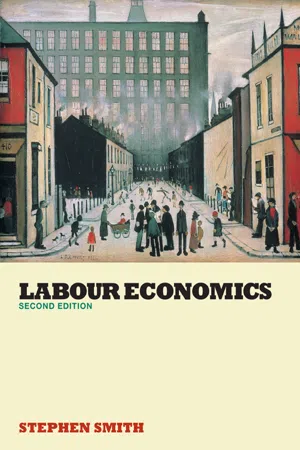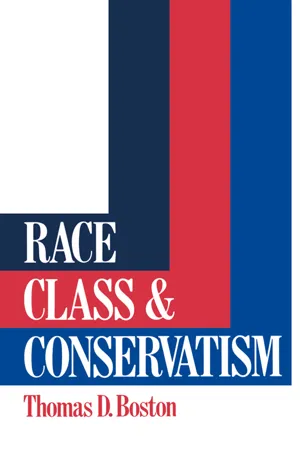Discrimination in the Labour Market
Discrimination in the labor market refers to the unfair treatment of individuals based on characteristics such as race, gender, age, or disability. This can manifest in hiring, promotion, and wage decisions. It can lead to unequal opportunities and outcomes for different groups of workers, ultimately impacting the overall efficiency and equity of the labor market.
5 Key excerpts on "Discrimination in the Labour Market"
- eBook - ePub
- Stephen W. Smith(Author)
- 2003(Publication Date)
- Routledge(Publisher)
...6 Labour market discrimination INTRODUCTION The economic analysis of discrimination focuses upon the possibility that significant wage and employment differences persist between groups within the labour force that are not justified by differential productivity and human capital investment. Do characteristics such as gender and race, which are economically irrelevant per se, significantly affect the labour market outcomes for individual labour suppliers? If so then the impact of gender and racial characteristics on earnings and employment outcomes can be regarded as labour market consequences of discrimination. In order to address the phenomenon of discrimination we need to examine economic theories of discrimination and the evidence provided by empirical studies of the topic. At the theoretical level there are two main schools of economic thought regarding discrimination. One is the neoclassical theory stemming from the work of Becker (1957) which is based on the notion that prejudice is expressed in discriminatory tastes on the part of employers, workers and consumers. The alternative is the segmented labour market approach, which can trace its heritage back to the theory of non-competing groups in the work of J.S. Mill (1885). The segmented labour market approach essentially maintains that the labour market is split into sectors including delineations according to sex and racial origin, and that there is very little interaction between those sectors. Examples of this approach are the ‘job crowding’ and the ‘dual labour market’ hypotheses. In this chapter we set out the neoclassical and segmented market approaches and survey some of the empirical evidence in the light of statistical data indicating discrimination. As a special focus to our treatment of discrimination we will assess the effectiveness of equal pay and opportunities legislation and consider the case for ‘comparable worth’ policies...
- eBook - ePub
Employment Equity and Affirmative Action: An International Comparison
An International Comparison
- Harish C. Jain, Peter Sloane, Frank Horwitz(Authors)
- 2015(Publication Date)
- Routledge(Publisher)
...Chapter 2 Theories of Discrimination Introduction The basis of discrimination against particular groups in the labor market has been a matter of considerable debate among social scientists. In general, it appears that an attempt has been made to apply a common framework to different groups, whether it be race, gender, religion, or age. An example is Gary Becker’s approach in the Economics of Discrimination (1957), which is based on the premise that certain groups have a taste for discrimination based on an aversion to other groups, for which they are prepared to pay a price as for any other commodity. But distinguishing, for instance, between race and gender, we can see that there are important differences between the two cases. Although races tend to remain separate entities, men and women most frequently marry. Therefore, the potential gains to racial discrimination to the extent that they exist seem larger than to gender discrimination in the context of a gains from trade model. Does the aversion have to do with physical distance at work or social distance? That is, is simple contact at work the issue or who gives and who takes orders? Marriage causes intermittent labor force participation for most women, and this may influence job choice. Genetic differences are more significant across gender than across race, and the same is possibly true in relation to tastes for particular types of work. This raises the question as to whether in the context of this book separate theories are needed to explain the phenomenon of discrimination in the three advanced industrialized countries represented here and the three developing economies with very different social and political structures. In this chapter, we will attempt to define what constitutes discrimination, recognizing that equality of opportunity does not necessarily imply equality of outcomes...
- eBook - ePub
Racial Discrimination
Institutional Patterns and Politics
- Masoud Kamali(Author)
- 2010(Publication Date)
- Routledge(Publisher)
...Here, the ‘market’ is constructed as a kind of force per se, and responsibility for prejudices is shifted off individuals and into this ‘sphere.’ There is a kind of circular logic through which immigrants are denied access to labour markets. The claim that clients and customers might react against immigrant employees permits gatekeepers to position themselves as benevolent and well-intentioned by not employing immigrants and thus ‘protecting’ them from such reactions and experiences. Assumptions Concerning the ‘Others’ Discrimination is a process of noting, perceiving, constructing a difference or distinction between members of an in-group (‘Us’) and members of an out-group (‘Them’) and deciding that these differences should qualify for differential treatment and justify the exclusion of the out-groups. In our study of the eight countries’ labour markets, we found that in daily interactions, migrants and members of some minorities are stereotyped as lacking language and ‘cultural competence,’ or as being unreliable, lazy, devious, and criminal. On the basis of such judgements, they are then ‘sentenced’ either to unemployment or to menial, hard, repetitive, dirty, and low paid tasks; in both ways they are denied equal opportunities with ‘natives’ when it comes to accessing a job or position. In the best case scenario, specific ‘skills’ or ‘talents’—such as being flexible, being able to take on hard workloads or the worst working times—become attributed to migrants or members of some minorities. In Europe, these ‘skills’ or ‘talents’ are then referred to in order to justify why they are given the jobs which hardly any ‘natives’ want to do. There are similarities between Europe and the United States in this respect...
- eBook - ePub
Workplace Equality in Europe
The Role of Trade Unions
- Anna Paraskevopoulou, Sonia McKay(Authors)
- 2016(Publication Date)
- Routledge(Publisher)
...Disability experts argue that the data concerning disability is too unreliable to make accurate assessments of the extent of discrimination, but are agreed that there is endemic discrimination against those who are disabled. This may not be demonstrated in overt forms but in the ways in which society is structured so that the disabled often appear invisible in the public arena, as an expert reporting to the Mapping study noted: Disabled people are still at significant disadvantage in the labour market in all European countries … They have, in general, lower participation rates, higher levels of unemployment and a lower educational attainment level, than the rest of the population. Most countries pursue active strategies to include and integrate people with disabilities in the labour market. However the degree of success is not always measured or evaluated. Age discrimination in relation to recruitment and retention presents problems to Europe’s older workers, as AGE Europe notes: It is therefore clear that age is fast becoming the most commonly perceived disadvantage in the labour market. This strongly reflects the reality that is faced by many older workers, in particular older women, who are among those most affected by the crisis and one of the groups most likely to lose their job and be unable to find new employment (Age Platform Europe, 2013). One in six Eurobarometer respondents reported personal experience of discrimination, with those with a disability or belonging to a sexual or ethnic minority being likely to do so. One in three respondents had themselves witnessed or had heard of someone who had suffered discrimination in the previous year. This means that when addressing discrimination it is important to take account not just of those who may directly experience discrimination but also to recognise that discriminatory actions have a ripple effect...
- eBook - ePub
- Thomas D Boston(Author)
- 2013(Publication Date)
- Routledge(Publisher)
...In the process, we will understand more fully the fundamental form of discrimination in contemporary labor markets. Yet for all its usefulness in race/class analyses, LMS theory must first be purged of its conservative integument. In particular, we challenge the theory’s explanation of the behavior of secondary-sector workers. But this, along with many other issues, is examined in detail below. The modern focus on segmented labor markets arose more than a decade after Becker’s seminal analysis of wage discrimination (1957). Influenced by early analyses of Balkanized labor markets, by Bergman’s examination of occupational crowding (1971), by Doeringer and Piore’s work on dual labor markets (1971) and by subsequent studies of segmented labor markets (Bluestone, 1970; Edwards, Reich and Gordon, 1975), economists’ preoccupation with wage discrimination began to shift. 1 Stiglitz puts pre-segmentation approaches in their clearest perspective. The central problem posed by the economics of discrimination is the following: Under what circumstances is it possible for groups with identical economic characteristics to receive different wages in a market equilibrium? If people of the same productivity receive different wages, then there are profits to be made by hiring the low wage individual. If all firms are profit maximizers, then all will demand the services of the low-wage individual, bidding their wages up until the wage differential is eliminated. Why does this not occur? (Stiglitz, 1973, p. 287) According to Marshall (1974), theoretical attempts to resolve this contradiction produced mechanical results that lacked congruence with reality (see related criticisms by Alexis and Medoff, 1984; Darity, 1982; Reich, 1981). The shortcomings of the early theories led economists in three divergent directions. One group sought to explain inequality by focusing upon factors external to the labor market but which nonetheless impacted the quality of black labor supplied...




